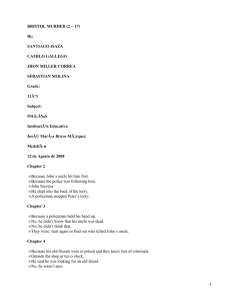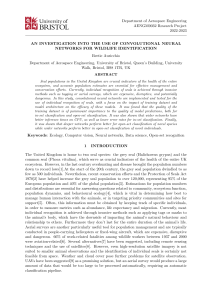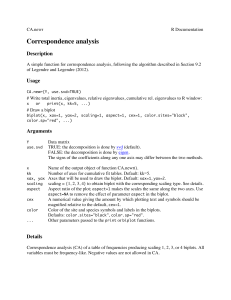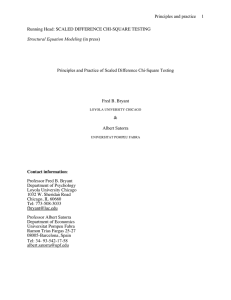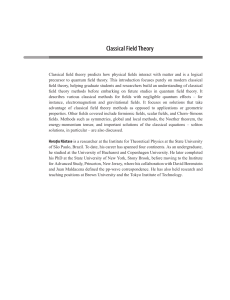Physiological Laws of Sensory Visual System in Relation to Scaling
Anuncio
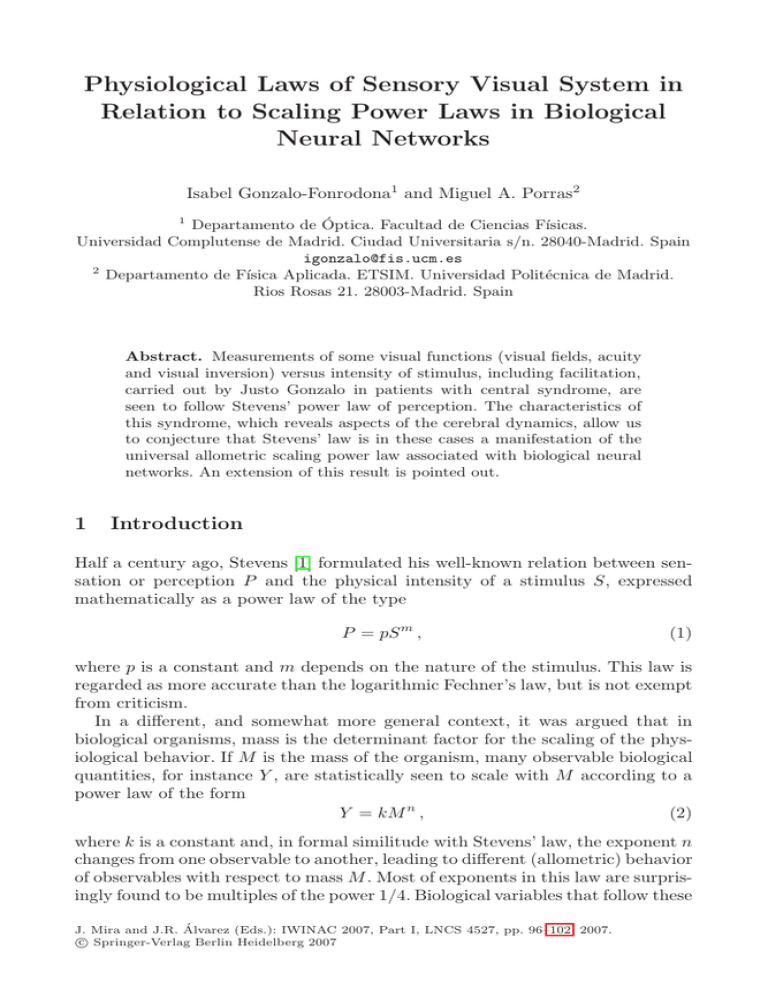
Physiological Laws of Sensory Visual System in Relation to Scaling Power Laws in Biological Neural Networks Isabel Gonzalo-Fonrodona1 and Miguel A. Porras2 1 Departamento de Óptica. Facultad de Ciencias Fı́sicas. Universidad Complutense de Madrid. Ciudad Universitaria s/n. 28040-Madrid. Spain igonzalo@fis.ucm.es 2 Departamento de Fı́sica Aplicada. ETSIM. Universidad Politécnica de Madrid. Rios Rosas 21. 28003-Madrid. Spain Abstract. Measurements of some visual functions (visual fields, acuity and visual inversion) versus intensity of stimulus, including facilitation, carried out by Justo Gonzalo in patients with central syndrome, are seen to follow Stevens’ power law of perception. The characteristics of this syndrome, which reveals aspects of the cerebral dynamics, allow us to conjecture that Stevens’ law is in these cases a manifestation of the universal allometric scaling power law associated with biological neural networks. An extension of this result is pointed out. 1 Introduction Half a century ago, Stevens [1] formulated his well-known relation between sensation or perception P and the physical intensity of a stimulus S, expressed mathematically as a power law of the type P = pS m , (1) where p is a constant and m depends on the nature of the stimulus. This law is regarded as more accurate than the logarithmic Fechner’s law, but is not exempt from criticism. In a different, and somewhat more general context, it was argued that in biological organisms, mass is the determinant factor for the scaling of the physiological behavior. If M is the mass of the organism, many observable biological quantities, for instance Y , are statistically seen to scale with M according to a power law of the form (2) Y = kM n , where k is a constant and, in formal similitude with Stevens’ law, the exponent n changes from one observable to another, leading to different (allometric) behavior of observables with respect to mass M . Most of exponents in this law are surprisingly found to be multiples of the power 1/4. Biological variables that follow these J. Mira and J.R. Álvarez (Eds.): IWINAC 2007, Part I, LNCS 4527, pp. 96–102, 2007. c Springer-Verlag Berlin Heidelberg 2007 Physiological Laws of Sensory Visual System 97 quarter-power allometric laws are, for instance, the metabolic rate (n 3/4), lifespan (1/4), growth rate (−1/4), height of trees (1/4), cerebral gray matter (5/4), among many others (see [2,3] and references therein, and also [4,5]). The allometric scaling laws are supposed to arise from universal mechanisms in all biological systems, as the optimization to regulate the activity of its subunits, as cells. According to West and Brown [6], optimization would be achieved through natural selection by evolving hierarchical fractal-like branching networks, which exchange energy and matter between the macroscopic reservoir and the microscopic subunits. Some examples of these networks are the animal circulatory, respiratory, renal and neural systems, the plant vascular system, etc. The quarter-power allometric laws can be theoretically derived from simple dimensionality reasonings that derive from the geometrical constraints inherent to these networks. As the same authors remark, powers proportional to a multiple of 1/4 would be strictly verified only in ideal biological organisms, while in real organisms the power may slightly depart from these values, since they are affected by stocastic factors, environmental conditions and evolutionary histories. For other authors [7], however, the scaling power laws are valid independently of the network type, and hence also for those without hierarchical or fractal structure. Though Stevens’ law for perception-stimulus relation and biological scaling law with mass relate to different phenomena, their formal similitude indicates a possible connection between them. A more fundamental connection is pointed out here on the basis of the measurements of some visual functions versus stimulation intensity, carried out by Gonzalo [8,9,10] in patients with the central syndrome that he described. After recalling the characteristics of this syndrome, we first verify that the measured data of the visual functions versus stimulus intensity fit well to Stevens’ power laws. Second, under reasonable assumptions on the relation between physical stimulus and activated neural mass, we conclude that Stevens’ law of perception is, in the cases studies at least, a manifestation of the universal scaling power laws. 2 Characteristics of the Central Syndrome The central syndrome (or symmetric poly-sensory syndrome) seems to be particularly suitable for the observation of the unfolding of the sensory functions. This syndrome originates from a unilateral parieto-occipital lesion equidistant from the visual, tactile and auditory projection areas, and is featured by [8,10] (a) poly-sensory affection with symmetric bilaterality, (b) functional disgregation of perception, in the sense that sensory qualities are gradually lost in a well-defined order as the stimulus intensity diminishes, and (c) capability to improve the perception by iterative temporal summation and by facilitation through other stimuli, as for instance, strong muscular stress. The syndrome was interpreted [10] as a deficit of cerebral integration due to a deficit of cerebral nervous excitation caused by the loss of a rather unspecific (multisensory) neural mass. This interpretation arises from a model in which functional sensory densities 98 I. Gonzalo-Fonrodona and M.A. Porras for each sensory system are distributed in gradation through the whole cortex [10,11]. There are other works dealing with this research [12,13,14,15,16,17], or related to it (e.g., [18,19,20]). A close connection can also be established with models based on a distributed character of cerebral processing, its adaptive and long-distance integrative aspects (e.g., [21]). The remarkable point here is that the central syndrome was explained in terms of a scale reduction of the normal cerebral system caused by the lesion [10,12]. From the concept of dynamic similitude, scaling laws were applied to the sensory decrease —or functional depression— observed in the patients. From the comparison between twelve cases with central syndrome in different degrees, their visual luminosity, acuity and other qualities were found to obey approximate power laws versus their respective visual field amplitudes, with different exponent for each quality, i.e., allometrically [10,12]. This is the formal description of the functional disgregation, or decomposition of the normal perception into its different qualities by their gradual loss, from the most to the less complex ones, as the nervous excitation diminishes, or equivalently, as the magnitude of the lesion grows. The organization of the sensorium can be then visualized, up to a certain extent, as displayed in patients with central syndrome. For a given individual with central syndrome, the sensory level grows by intensifying the stimulus, or by adding other different stimuli, which are able to compensate for the neural mass lost. This dynamic capability is greater as the neural mass lost is greater, and is null, or extremely low for some functions, in a normal man. [8,10,13]. 3 Stevens’ Law in Central Syndrome All experimental data presented are taken from Ref. [8], correspond to two different cases with central syndrome, called M and T (less intense), and refer to the change of visual functions or qualities with intensity of stimulation in a stationary regime. Stevens’ law [Eq. (1)] is used to fit the data. Figure 1(a) shows the experimental data for the visual field amplitude of right eye in cases M, M facilitated by strong muscular stress (40 kg held in his hands), and case T, as functions of the illumination of the test object. The reduction of the visual field in the central syndrome is concentric. In the log-log graphic, Stevens’ law [Eq. (1)] yields a straight line of slope equal to the exponent m. As seen, the data fit rather well to Stevens’ straight lines not very close to saturation. The slope m of the fitting straight lines is remarkably close to 1/4 for M and M facilitated, and 1/8 for T. In Fig. 1(b), similar representation is shown for the visual acuity in central vision, including a normal man. Straight lines with slope 1/4 fit well to the central part of the data for the two states of case M and for case T, and with slope 1/8 for normal man. In another series of experiments, the intensity of light on the test object was kept constant and low, whereas the variable stimulus was the facilitation supplied by muscular stress [Fig. 2(a) and (b)], or by light on the other eye (Fig. 3). Fig. 2(a) shows the measured visual field amplitude of right eye in case M Physiological Laws of Sensory Visual System 99 Fig. 1. (a) Visual field of right eye versus relative illumination (test object: 1 cmdiameter, white disk). Squares: M (fitting straight line with slope 1/4). Circles: M facilitated (straight line with slope 1/4). Triangles: T (straight line with slope 1/8). (b) Acuity of right eye versus illumination. Squares: M (fitting with slope 1/4). Circles: M facilitated (fitting with 1/4). Triangles: T (fitting with 1/4). Inverted triangles: Normal man (fitting with 1/8). Fig. 2. (a) Visual field amplitude in right eye versus facilitation by muscular stress. Squares: M, 0.5 cm test size (fitting straight line with slope 1/2). Circles: M, 1.0 cm test size (fitting slope 1/3). (b) Visual direction (reinversion) in right eye versus facilitation by muscular stress. Squares: M (fitting slope 1/4). Fig. 3. Visual direction (reinversion) in right eye versus facilitation by illumination on left eye. Squares: M (fitting straight line with slope 1/8). 100 I. Gonzalo-Fonrodona and M.A. Porras holding in his hands increasing weights. The data fit again to straight lines with slopes (Stevens’ powers) 1/2 and 1/3 for the two different diameters of the white circular test object. Fig. 2(b) shows data under similar conditions as in Fig. 2(a) but the sensory function measured is the recovery of the upright direction (180 degrees) of a vertical white arrow that the patient perceived tilted or almost inverted (0 degrees) under low illumination [8,9,10,15,16,17]. The improvement of perception with facilitation by muscular stress shows good agreement with Stevens’ law with power 1/4. We note however that the visual direction function versus illumination of the test object does not show an evident agreement with Stevens’ law. Under the same conditions as in the preceding figures, the novelty in Fig. 3 is that facilitation is supplied by illuminating the left eye, which does not see the object. Again, the data can be well fitted with Stevens’ law, but now with power 1/8. The improvement of perception with increasing stimuli in patients with central syndrome is then seen to be describable from Stevens’ law of perception, with a noticeable number of exponents around 1/4, as in scaling biological laws. The observed loss of accuracy for very low and very high stimuli reflects the approximate character of Stevens’ law, considered as valid only in limited ranges of stimuli. 4 The Underlying Biological Scaling Power Laws It is not difficult to trace Stevens’ law in the cases studied to the allometric scaling power laws. The stimulus induces nervous impulses which originate a cerebral excitation, which in essence can be assimilated to the activation of a number of neurons, or, in other terms, to the activation of a neural mass. Mass is in fact the fundamental magnitude involved in biological scaling laws. Reasonable assumptions on the relation between stimulus S and activated neural mass Mneur can be established on the following basis. First, the disorders in patients with central syndrome were interpreted to be the result of a deficit of integration of neural mass Mneur at low stimuli S. With increasing stimuli, perception tends to be normal due apparently to the increase of mass recruited. In this sense but in normal man, the recent work of Arthurs et al. [22] describes the relation between electrical stimuli and electrophysiological or neuroimaging measures of the human cortical response as a power law, with an average exponent around 1.3 (see also Ref. [23]). These considerations support our assumption that the activated neural mass as a function on the intensity of a stimulus can be approximately described by the power law (3) Mneur = αS β , where β is expected to depend on the nature of the stimulus. Equation (3) can 1/β be equivalently written as S = α Mneur , which introduced into Stevens’ law (1) yields 1/β m n ) = kMneur , (4) P = pS m = (α Mneur with n = m/β. Physiological Laws of Sensory Visual System 101 The last equality in Eq. (4) is a power law with respect to neural mass, and hence a scaling power law associated to the neural network, the exponent being then expected to fit in many cases to multiples of 1/4, as stated in the introduction. 5 Discussion and Conclusion From expression (4), and taking the network scaling power laws as more fundamental, it can be concluded that the physiological Stevens’ law in cases with central syndrome is a manifestation of the scaling power laws. Increasing intensity of stimulation would result in increasing activated neural mass according to a power law, which in turn leads to an improvement of perception. This conclusion is also supported by the fact that many powers m = nβ in the experimental fittings with Stevens’ law are found to be close to 1/4, since n = 1/4 is very often the basic power in scaling laws and β is reported to be close to unity [22]. In normal man, some of the sensory functions analyzed here (amplitude of visual field and direction function) attain permanently its maximum value. Even for stimuli with very low intensity, the cerebral excitation in normal man suffices for the normal value of the sensory function to be reached (e.g., the whole visual field and the upright perception of the visual scene), which can be thought as a “saturated” situation. Other functions as visual acuity, vary in normal man with the intensity of the stimulus, but with a very low exponent as seen in Fig. 1(b), which would reflect a situation close to the “saturation” limit. In this respect, let us mention the scaling power law found between the number of neurons in the visual cortex V1 and the number of neurons in the visual thalamus (roughly the same as the number of retinal ganglion cells) in primates [24], which suggests that visual acuity depends not only on the type of cells activated in retina, but also on an integrative process in the cortex. This was also suggested by the behavior of acuity in central syndrome [8]. As an extension of these results, we finally suggest that Stevens’ law of perception also in normal man could originate from the scaling power laws that govern the dynamic behavior of biological neural networks. References 1. Stevens, S.S.: On the psychophysical law. Psychol. Rev. 64 (1957) 153-181 2. West, G.B., Brown, J.H.: Life’s Universal Scaling Laws. Phys. Today. Sept. (2004) 36-42 3. West, G.B., Brown, J.H.: The origin of allometric scalin laws in biology from genomes to ecosystems: towards a quantitative unifying theory of biologica structure and organization. J. Exper. Biol. 208 (2005) 1575-1592 4. Anderson, R.B.: The power law as an emergent property. Mem. Cogn. 29 (2001) 1061-1068 5. Gisiger, T.: Scale invariance in biology: coincidence or footprint of a universal mechanisms? Biol. Rev. 76 (2001) 161-209 102 I. Gonzalo-Fonrodona and M.A. Porras 6. West, G.B., Brown, J.H.: A general model for the origin of allometric scalling laws in biology. Science 276 (1997) 122-126 7. Banavar, J.R., Maritan, A., Rinaldo, A.: Size and form in efficient transportation networks. Nature 399 (1999) 130-132 8. Gonzalo, J: Investigaciones sobre la nueva dinámica cerebral. La actividad cerebral en función de las condiciones dinámicas de la excitabilidad nerviosa. Publicaciones del Consejo Superior de Investigaciones Cientı́ficas, Inst. S. Ramón y Cajal, Madrid, Vol. I (1945), Vol. II (1950). (Avalable in: Instituto Cajal, CSIC, Madrid) 9. Gonzalo, J.: La cerebración sensorial y el desarrollo en espiral. Cruzamientos, magnificación, morfogénesis. Trab. Inst. Cajal Invest. Biol. 43 (1951) 209-260 10. Gonzalo, J.: Las funciones cerebrales humanas según nuevos datos y bases fisiológicas: Una introducción a los estudios de Dinámica Cerebral. Trab. Inst. Cajal Invest. Biol. 44 (1952) 95-157 11. Gonzalo, I., Gonzalo, A.: Functional gradients in cerebral dynamics: The J. Gonzalo theories of the sensorial cortex. In Moreno-Dı́az, R., Mira, J. (eds.): Brain Processes, Theories and Models. An Int. Conf. in honor of W.S. McCulloch 25 years after his death. The MIT Press, Massachusetts (1996) 78-87 12. Gonzalo, I.: Allometry in the J. Gonzalo’s model of the sensorial cortex. Lect. Not. Comp. Sci (LNCS) 1249 (1997) 169-177 13. Gonzalo, I.: Spatial Inversion and Facilitation in the J. Gonzalo’s Research of the Sensorial Cortex. Integrative Aspects. Lect. Not. Comp. Sci. (LNCS) 1606 (1999) 94-103 14. Gonzalo, I., Porras, M.A.: Time-dispersive effects in the J. Gonzalo’s research on cerebral dynamics. Lect. Not. Comp. Sci (LNCS) 2084 (2001) 150-157 15. Gonzalo, I., Porras, M.A.: Intersensorial summation as a nonlinear contribution to cerebral excitation. Lect. Not. Comp. Sci. (LNCS) 2686 (2003) 94-101 16. Arias, M., Gonzalo, I.: La obra neurocientı́fica de Justo Gonzalo (1910-1986): El sı́ndrome central y la metamorfopsia invertida. Neurologı́a 19 (2004) 429-433 17. Gonzalo-Fonrodona, I.: Inverted or tilted perception disorder. Rev. Neurol. 44 (2007) 157-165 18. Delgado, A.E.: Modelos Neurocibernéticos de Dinámica Cerebral. Ph.D.Thesis. E.T.S. de Ingenieros de Telecomunicación, Univ. Politécnica, Madrid (1978) 19. Mira, J., Delgado, A.E., Moreno-Dı́az, R.: The fuzzy paradigm for knowledge representation in cerebral dynamics. Fuzzy Sets and Systems 23 (1987) 315-330 20. Mira, J., Manjarrés, A., Ros, S., Delgado, A.E., Álvarez, J.R.: Cooperative Organization of Connectivity Patterns and Receptive Fields in the Visual Pathway: Application to Adaptive Thresholdig. Lect. Not. Comp. Sci. (LNCS) 930 (1995) 15-23 21. Rodrı́guez, E., George, N., Lachaux, J.P., Martinerie, J., Renault, B., Varela, F.J.: Perceptions shadow: long-distance synchronization of human brain activity. Nature 397 (1999) 430-433 22. Arthurs, O.J., Stephenson, C.M.E., Rice, K., Lupson, V.C., Spiegelhalter, D.J., Boniface, S.J., Bullmore, E.T.: Dopaminergic effects on electrophysiological and functional MRI measures of human cortical stimulus-response power laws. NeuroImage 21 (2004) 540-546 23. Nieder, A., Miller, E.K.: Coding of cognitive magnitude. Compressed scaling of numerical information in the primate prefrontal cortex. Neuron 37 (2003) 149-157 24. Stevens, C.F.: An evolutionary scaling law for the primate visual system and its basis in cortical function. Nature 411 (2001) 193-195
